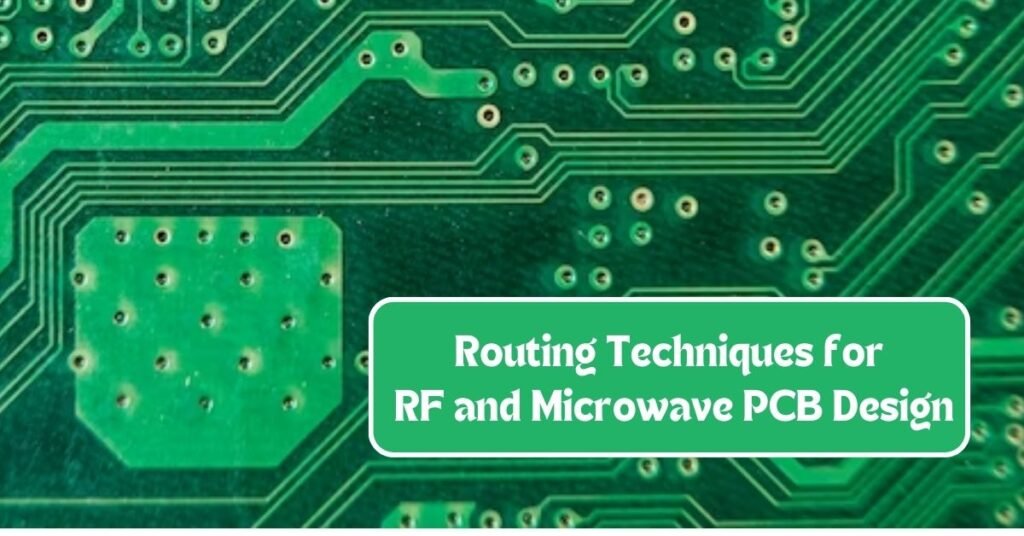
RF (Radio Frequency) and microwave PCB design require careful consideration of routing techniques to ensure signal integrity, minimize losses, and achieve optimal performance. In this article, we’ll explore the importance of routing techniques in RF and microwave PCB design and discuss effective strategies for achieving high-quality designs. PCB design services play an important role in providing expertise and support to companies seeking to develop RF and microwave circuits with superior performance and reliability.
Importance of Routing Techniques in RF and Microwave PCB Design
In RF and microwave PCB design, signal integrity is paramount. The transmission of high-frequency signals requires precise routing to minimize signal distortion, reflections, and losses. Proper routing techniques help maintain signal integrity, impedance matching, and controlled impedance throughout the PCB layout, ensuring that RF and microwave circuits operate as intended.In addition to signal integrity considerations, proper routing techniques in RF and microwave PCB design also play a critical role in minimizing electromagnetic interference (EMI) and ensuring compliance with regulatory standards. By carefully planning the layout and routing of high-frequency traces, designers can reduce the risk of EMI-induced issues such as cross-talk and radiation, thus improving the overall performance and reliability of the PCB. Furthermore, adherence to best practices in routing techniques enables designers to meet stringent specifications for frequency response, power handling, and noise immunity, resulting in robust RF and microwave circuits capable of meeting the demanding requirements of modern electronic systems.
Effective Routing Techniques
Impedance Matching: Impedance matching is critical in RF and microwave PCB design to minimize signal reflections and maximize power transfer. Use controlled impedance traces and matching networks to ensure that the characteristic impedance of transmission lines matches the impedance of connected components or devices.
Transmission Line Routing: RF and microwave signals should be routed as transmission lines to maintain signal integrity and prevent signal degradation. Use techniques such as microstrip, stripline, and coplanar waveguide (CPW) routing depending on the application requirements and frequency range.
Minimize Signal Crossings: Avoid crossing RF and microwave signal traces with other signals or components to prevent signal coupling and interference. Maintain adequate separation between signal traces to minimize crosstalk and ensure isolation between different RF circuits. Utilizing tools such as Allegro PCB can aid designers in implementing these practices effectively, providing features and functionalities specifically tailored for RF and microwave PCB layout, ensuring optimal signal integrity and minimal interference.
Keep Signal Paths Short: Minimize the length of signal traces and avoid sharp bends or corners to reduce signal losses and impedance mismatch. Short, direct signal paths help maintain signal integrity and minimize transmission line effects such as attenuation and dispersion.
Use Ground Planes: Ground planes act as reference planes for signal traces and help provide a low-impedance return path for RF and microwave signals. Ensure solid ground planes with minimal interruptions or splits to minimize ground loops and electromagnetic interference (EMI).
Avoid Stub Traces: Stub traces can cause impedance mismatch and signal reflections, particularly at high frequencies. Minimize stub lengths and avoid open-ended stubs by terminating unused transmission line stubs properly.
Optimize Via Placement: Vias introduce impedance changes and discontinuities in RF and microwave circuits. Place vias strategically to minimize their impact on signal integrity and impedance matching. Use through-hole vias for lower frequencies and consider using blind or buried vias for high-density designs or multilayer PCBs.
Differential Pair Routing: Differential signaling is common in RF and microwave circuits to improve noise immunity and signal integrity. Route differential pairs close together with consistent spacing and ensure matched trace lengths to maintain signal symmetry and minimize common-mode noise.
High-Quality Substrates: Select high-quality PCB substrates with low dielectric loss and low dispersion characteristics for RF and microwave applications. Choose materials with consistent electrical properties over a wide frequency range to ensure predictable performance. Leveraging tools like OrCAD PCB Designer can facilitate the selection and optimization of substrate materials, allowing designers to simulate and analyze the impact of different substrate choices on RF and microwave circuit performance, thereby ensuring optimal design outcomes.
Simulation and Verification: Use RF simulation tools to validate the performance of RF and microwave PCB designs. Perform electromagnetic simulations to analyze signal propagation, impedance matching, and electromagnetic interference effects. Verify designs through prototyping and testing to ensure compliance with specifications and requirements.
In conclusion, routing techniques play a crucial role in achieving high-performance RF and microwave PCB designs. By implementing effective routing strategies such as impedance matching, transmission line routing, signal isolation, and careful via placement, designers can ensure optimal signal integrity, minimize losses, and achieve reliable operation in RF and microwave circuits. Additionally, thorough simulation and verification help validate design performance and ensure compliance with specifications, leading to successful RF and microwave PCB designs.PCB layout services further enhance these outcomes by providing expertise in optimizing component placement, trace routing, and overall PCB layout to maximize the performance and reliability of RF and microwave circuits.